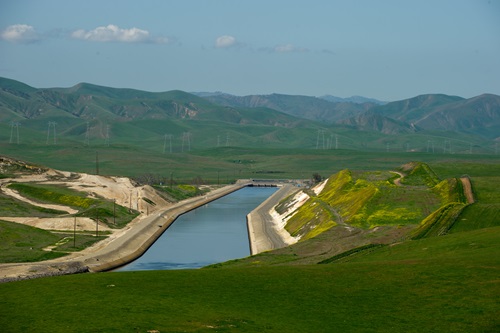SWP Management

Looking north from the California Aqueduct Vista Point on Interstate 5 in Stanislaus County. DWR/2013.
The water supply availability for delivery by the SWP depends on rainfall, snowpack, runoff, reservoir storage, pumping capacity of SWP facilities, and regulatory and environmental mandates on SWP operations. Water from rainfall and snowmelt runoff is stored in SWP conservation facilities such as Lake Oroville, flows through the Delta and is delivered via SWP transportation facilities like the California Aqueduct. Water deliveries have ranged from 17 thousand acre-feet (af) in 1962 to about 3.7 million af in 2006.
Long-term Water Supply Contracts
While the SWP was being constructed in the 1960s, public agencies and local water districts signed long-term water supply contracts with DWR. Today, the 29 public agencies and local water districts are collectively known as the SWP long-term water contractors or simply, SWP water contractors. The water supply contracts (which expire in 2035) set forth the maximum amount of SWP water a contractor may request annually (see Table A amounts, below). However, the amount of SWP water available for delivery will vary yearly, based on hydrologic conditions, current reservoir storage, and combined requests from the SWP water contractor.
Contractually, the SWP water contractors agree to repay principal and interest on both the general obligation bonds that funded the initial SWP construction and the revenue bonds that paid for additional facilities. The SWP water contractors also pay all associated costs, including labor and power, incurred for maintaining and operating the SWP facilities.
The SWP water contractors are principally located in the San Francisco Bay Area, the central California Coast, the San Joaquin Valley and Southern California. SWP contractor service areas extend from Plumas County in the north to San Diego County adjacent to the Mexican border. In total, the contractor service areas comprise almost one quarter of California's land area and more than two-thirds of its population. While most of the SWP water contractors have been in existence for many years, a number of new water districts have formed for the express purpose of contracting for SWP water.
The SWP made its first deliveries in 1962 to the Bay Area. In 1968, service was extended into the central and southern San Joaquin Valley and by 1972, Southern California areas began receiving their first SWP deliveries.
In most cases, SWP water contractors use SWP water to supplement their local or other imported supplies. Five SWP water contractors use SWP water primarily for agricultural purposes (mainly in the southern San Joaquin Valley); the remaining 24 primarily for municipal purposes.
SWP Allocation
2026 Initial Allocation
The SWP initial allocation for 2026 is 10 percent of Table A, as presented in Notice to Contractors 25‑06.
Historical Allocations
Since 1996, all SWP allocations have been announced in notices to SWP contractors (NTCs) and are summarized in this document. An allocation history from 1967 through 1995 is available in this document.
+
